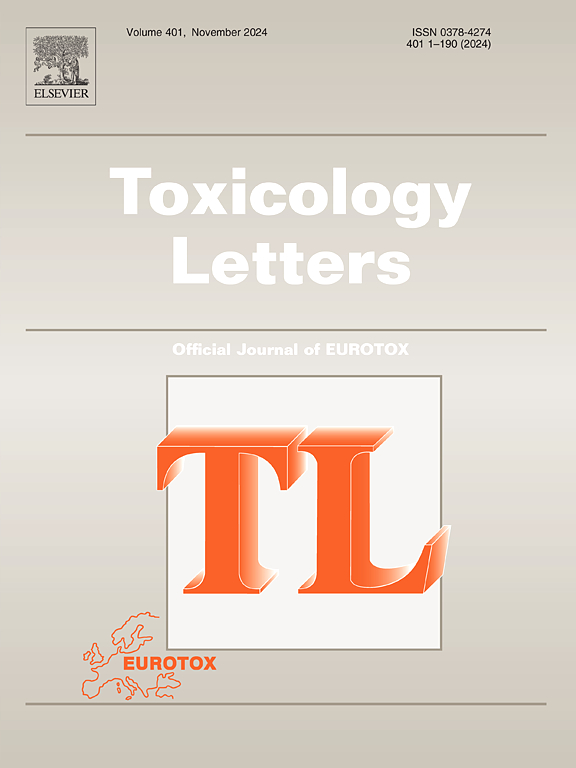Toxicity assessment of the novel psychoactive substance HU-210 (Hebrew University 210; CAS: 112830–95-2): First insight into toxicophores and critical toxicity parameters (acute toxicity, health effects, genotoxicity, skin and eye irritation, cardiotoxicity and endocrine disruption) using in silico methods for applications in clinical and forensic toxicology
IF 2.9
3区 医学
Q2 TOXICOLOGY
引用次数: 0
Abstract
Purpose
For the first time, the toxicity of HU-210, a synthetic cannabinoid, has been assessed using nine different in silico methods, representing a novel approach in substance safety research. Given the scant data on HU-210’s human toxicological impact, our research sought to predict toxicophores and key toxicological endpoints for clinical toxicology and forensic purposes.
Methods
We applied nine different in silico predictive methods, including: StopTox, AdmetSAR 3.0, ACD/Labs Percepta, ProTox 3.0, PreADMET, ADMETlab 2.0, OCHEM, TEST and VEGA QSAR to evaluate key toxicological endpoints: acute toxicity (LD50 for different species and route of exposure), genetic toxicity (Ames test), skin and eye irritation, health effects (gastrointestinal system, kidneys, liver, blood, lungs, and cardiovascular system), cardiotoxicity (hERG blocker/inhibitor and IC50) and endocrine system disruption. These in silico methods utilized computational models and existing databases to assess HU-210’s chemical interactions and toxicological profiles across several parameters.
Results
Predictive analyses indicated moderate acute toxicity risks for HU-210, particularly affecting the cardiovascular, renal, and pulmonary systems. While genotoxicity appeared low, substantial concerns were raised regarding its potential to disrupt the endocrine system. Despite variances in individual software predictions, the consensus underscored significant caution regarding HU-210’s safety profile.
Conclusions
Our findings emphasize the need for comprehensive toxicological assessments of new psychoactive substances (NPS) like HU-210 and highlight the critical role of in silico studies as preliminary research tools. Although these predictions provide valuable insights for clinical toxicology (expected health effects, genotoxicity, cardiotoxicity, endocrine system disruption) and forensic toxicology (especially acute toxicity), further experimental research is crucial. Notably, toxicophore analysis identified aromatic and unsaturated moieties within the chromene core of HU-210 as structural alerts potentially associated with toxicity. Regulatory bodies should consider these potential risks, highlighting the importance of ongoing vigilance in monitoring synthetic cannabinoids—an aspect particularly crucial from a forensic toxicology perspective.
新型精神活性物质HU-210的毒性评价(希伯来大学210;CAS: 112830-95-2):首次深入了解毒性团和关键毒性参数(急性毒性、健康影响、遗传毒性、皮肤和眼睛刺激、心脏毒性和内分泌干扰),使用计算机方法应用于临床和法医毒理学。
目的:首次使用9种不同的计算机方法对合成大麻素HU-210的毒性进行了评估,代表了物质安全性研究的新方法。鉴于HU-210对人体毒理学影响的数据不足,我们的研究试图预测临床毒理学和法医目的的毒理学终点和关键毒理学终点。方法:采用StopTox、AdmetSAR 3.0、ACD/Labs Percepta、ProTox 3.0、PreADMET、ADMETlab 2.0、OCHEM、TEST和VEGA QSAR等9种不同的计算机预测方法评估关键毒理学终点。急性毒性(不同物种和接触途径的LD50)、遗传毒性(Ames试验)、皮肤和眼睛刺激、健康影响(胃肠道系统、肾脏、肝脏、血液、肺和心血管系统)、心脏毒性(hERG阻滞剂/抑制剂和IC50)和内分泌系统干扰。这些计算机方法利用计算模型和现有数据库来评估HU-210的化学相互作用和多个参数的毒理学特征。结果:预测分析表明,HU-210有中度急性毒性风险,特别是对心血管、肾脏和肺系统的影响。虽然遗传毒性似乎很低,但人们对其可能破坏内分泌系统的问题提出了重大关切。尽管个别软件的预测存在差异,但共识强调了对HU-210安全性的重大警告。结论:我们的研究结果强调了对HU-210等新型精神活性物质(NPS)进行全面毒理学评估的必要性,并强调了计算机研究作为初步研究工具的关键作用。尽管这些预测为临床毒理学(预期健康影响、遗传毒性、心脏毒性、内分泌系统干扰)和法医毒理学(特别是急性毒性)提供了有价值的见解,但进一步的实验研究至关重要。值得注意的是,毒理学分析发现,HU-210的铬核内的芳香和不饱和部分是可能与毒性相关的结构警报。监管机构应该考虑这些潜在的风险,强调在监测合成大麻素方面保持警惕的重要性——从法医毒理学的角度来看,这是一个特别重要的方面。
本文章由计算机程序翻译,如有差异,请以英文原文为准。
求助全文
约1分钟内获得全文
求助全文
来源期刊

Toxicology letters
医学-毒理学
CiteScore
7.10
自引率
2.90%
发文量
897
审稿时长
33 days
期刊介绍:
An international journal for the rapid publication of novel reports on a range of aspects of toxicology, especially mechanisms of toxicity.
 求助内容:
求助内容: 应助结果提醒方式:
应助结果提醒方式:


